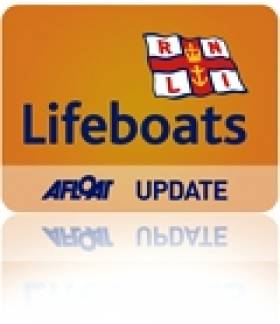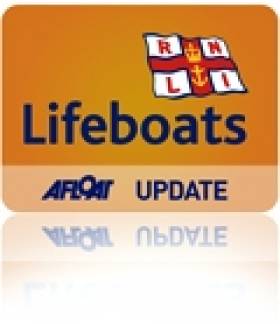Displaying items by tag: Station to Station
Station To Station Challenge Raises More Than €2,000 For RNLI
#RNLI - Two men who embarked on the first RNLI Station to Station challenge between Bundoran and Arranmore last Saturday (6 April) completed the job in just under 12 hours - raising over €2,000 for both lifeboat stations in the process.
As per their plan reported previously on Afloat.ie, Niall Clancy and James McIntyre both set off from Bundoran Lifeboat Station just after 6am on Saturday morning – Clancy running and McIntyre cycling.
Clancy's route took him through Bundoran, Ballyshannon, Donegal town, Mountcharles, Frosses, Glenties, Gweebarra Bridge, Lettermacaward, Dungloe, Burtonport and finally Arranmore Island via a treadmill on the ferry!
He was joined on various legs of the journey by members of the Tir Chonaill Athletic Club who kept his spirits up on the 100km journey from station to station.
Meanwhile, McIntyre and his team from Mullaghmore Triathlon Club and Donegal Bay Cycling Club took off at the same time cycling as far as Lough Eske, where James then made the lonesome journey himself across the Bluestack Mountains, constantly keeping organisers informed of his progress via text message.
Down into Glenties and from there by bike to Portnoo where, with Bundoran RNLI crewman Killian O’Kelly, he kayaked the remaining 22km to Arranmore Island, where both he and Clancy were greeted by the lifeboat crew and the Arranmore Pipe Band.
Speaking on completion of the challenge at Arranmore RNLI Lifeboat Station, Clancy said: "It’s been a long but great day. The weather conditions couldn’t have been any better for both myself and James – though it was very cold this morning leaving Bundoran!
"I’m looking forward to a few weeks off training before I get back into it for the Athlone Half Ironman in August."
McIntyre added: "We’d both like to express our gratitude to everyone who supported us ahead of the challenge and today – particularly those who sponsored us and those who ran and cycled with us today, our support teams, our chefs, the RNLI crews and sponsors Ormston’s Mace Ballyshannon and All Sports Donegal Town."
Shane Smith, volunteer lifeboat press officer for Bundoran RNLI, said: "We are thrilled at the success of the challenge and delighted that over €2,000 has been raised for both stations.
"We are indebted to James and Niall for their selfless support of our charity and would like to thank them sincerely on behalf of both crews."
Elsewhere, a Wexford family who organised a sponsored swim in memory of a loved one and former volunteer have raised a whopping €5,000 for Kilmore Quay RNLI.
The Hayes family presented the cheque to the RNLI at Kilmore Quay lifeboat station recently, funded by a sponsored swim on St Stephen’s Day organised by the family in memory of the late Paddy Hayes, who was a volunteer with the lifeboat.
Challengers Gear Up For RNLI Station to Station
#RNLI - Two men are in training to complete the first RNLI Station to Station challenge on Saturday 6 April travelling from Bundoran Lifeboat Station to Arranmore Island Lifeboat Station in 10 hours – by foot, bicycle and kayak.
Leaving Bundoran lifeboat station at 6am on Saturday 6 April, Niall Clancy and James McIntyre will take two different routes and two different means to complete their challenge.
Clancy is set to run the entire distance of 100km door to door, including using a treadmill on the final leg from Burtonport Ferry Port via ferry to Arranmore Island, while McIntyre will cycle to Barnesmore Gap, run across the Blue Stacks down to Glenties, cycle to Portnoo and then kayak the remainder of the journey to Arranmore Island.
Clancy, a HSE advance paramedic, has already completed three marathons including Belfast and Dublin and also a half Ironman triathlon in Galway. He decided to do the challenge following a conversation with the Arranmore lifeboat crew during a recent visit.
He said: "The RNLI is a fantastic charity and as it is voluntary I wanted to do my bit to help raise funds for both Bundoran and Arranmore so, with James, we’re aiming to do that on 6 April."
Initially the plan had been to run 36 miles but when the idea was put to him to run from Bundoran to Arranmore, which is a further marathon distance of 26 miles, Clancy thought it was a great idea.
"Running 100km is something different and definitely a challenge – I definitely believe we can do it."
Meanwhile, McIntyre is no stranger to such challenges having completed a Coast to Coast challenge for Parkinson's last year, again using the combination of mountain running, cycling and kayaking to traverse Northern Ireland and end up at Creevy Pier.
McIntyre is always looking for the next idea to top his last one and is always happy to do it for charity.
On the day the two boys and their entourages will have support from the Bundoran and Arranmore lifeboat crews as well as runners, cyclists and members of the Tir Chonaill Athletic Club. Donations can be made in advance via the RNLI Station to Station website. The boys’ progress on the day can be followed on the Bundoran RNLI Facebook page, on Twitter @atlantic85 and also on the website.






























































